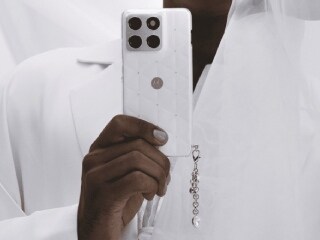- Home
- Mobiles
- Mobiles Reviews
- Karbonn K9 Kavach 4G and Karbonn Aura Note 2 Review
Karbonn K9 Kavach 4G and Karbonn Aura Note 2 Review

Indian smartphone maker Karbonn has been selling its devices for a really long time. It was also among the few smartphone makers to participate in Google's Android One programme. Karbonn has been quite aggressive in the budget segment, so much so that all of its devices are priced under Rs 14,000.
Sticking with this strategy, the company has launched the Karbonn K9 Kavach 4G and Karbonn Aura Note 2. Their prices are not that far apart and both have similar hardware, but different target audiences. We put these two phones to the test to see how they fare against the competition and each other.
Karbonn K9 Kavach 4G design and specifications
The K9 Kavach is the smaller of the two devices and sports a 5-inch display. It has a resolution of 720x1280 pixels. It has capacitive touch buttons below the display that aren’t backlit, and we did have trouble finding them in the dark. Of the two devices, the K9 Kavach has a better display, because it is more pixel dense at 293ppi and has significantly better viewing angles as well. On the other hand, sunlight legibility isn’t all that great and we had a hard time reading the screen even with the brightness cranked all the way up.
![]()
We had a Champagne colour version for review which was okay to look at. The power and volume buttons are on the right side while the Micro-USB port and 3.5mm audio socket are on the top. The phone is made out of plastic and its back cover is removable. Under the cover is a replaceable 2300mAh battery. The K9 Kavach is a dual-SIM phone with two Micro-SIM slots plus a dedicated microSD card slot. While the microSD card is hot-swappable, the SIMs will need you to pull the battery out.
There's a 5-megapixel camera on the back with a dual-LED flash and a fingerprint sensor below them. At the front, the K9 Kavach has a 5-megapixel camera along with a selfie flash. The smartphone is powered by a quad-core MediaTek MT6737 processor clocked at 1.25GHz. It has 1GB of RAM and 8GB of storage, out of which we had less than 4GB at our disposal. MicroSD cards of up to 32GB are supported.
Karbonn Aura Note 2 design and specifications
The Aura Note 2, on the other hand, is slightly bigger and has a 5.5-inch display with the same resolution of 720x1280 pixels. Below the display are backlit capacitive touch buttons for navigation. We didn’t find the display of the Aura Note 2 all that great. Colours weren’t accurate and viewing angles were strictly average. Sunlight legibility was a problem here too, as the screen is quite reflective under sunlight.
This phone is also made out of plastic and we weren’t really impressed with its build quality. The back cover is quite thin and you need to apply considerable force to unlatch it. It also flexes and feels like it might crack if force is applied. Under this cover is a 2900mAh battery along with two SIM slots and a microSD card slot.
![]()
The Aura Note 2 is available in three colours: Blue, Coffee and Black, all of which have a champagne-coloured mid-frame. There's a 13-megapixel camera at the back with a tiny single-LED flash. At the front, there's a 5-megapixel camera just like the K9 Kavach but without the selfie flash.
Just like the K9 Kavach, the Aura Note 2 is powered by a quad-core MediaTek MT6737 clocked at 1.25GHz, but this time there's 2GB of RAM and 16GB of storage. You can expand storage using a microSD card of up to 32GB.
Karbonn K9 Kavach 4G and Karbonn Aura Note 2 software and performance
Karbonn ships both phones with Android 7.0 Nougat. They have a stock-Android-like interface with minor changes in the Settings app. You get MediaTek’s MiraVision technology, which lets you tweak the display to suit your taste. There's also an option called DuraSpeed in the Settings app, which claims to freeze background apps in order to allocate more RAM to the apps in the foreground. We did try this on both phones but didn’t feel that it made a significant difference.
As the two devices are targeted at different audiences, they have with different pre-installed apps. One of the K9 Kavach's biggest features is that it comes with the BHIM app preinstalled, which can be used to send or receive money. This phone also has a fingerprint app lock which lets you secure apps with your fingerprint. Apart from BHIM there is PhonePe, another payments app. You also have a bunch of other apps including Saavn, Xender, DailyHunt and Cricbuzz.
![]()
The performance of the K9 Kavach is just about right for a phone at its price. The 1GB of RAM does feel like a bottleneck when multitasking and this phone routinely kills the apps in the background. If you are planning to play games on your phone then be prepared for longer load times as apps in memory are cleared to load large games. We found that we had only about 300MB free on average which is a bit too low these days.
In terms of benchmarks, the K9 Kavach returned 29,475 in AnTuTu, as well as 528 and 1464 for the single-core and multi-core tests in Geekbench. The K9 Kavach has a 2300mAh battery that managed to go on for only 6 hours and 43 minutes in our HD video loop test. We found battery performance to be below average as this phone struggled to last through one day with low to medium use.
On the other hand, the Aura Note 2 comes with a few preloaded game demos, including Modern Combat 4 and Spiderman. Other apps include Vistoso and Fashion Eye which we also found preinstalled on the Intex Aqua Crystal. Karbonn Klinic, an after sales support app, can be very spammy. While the Aura Note 2 has the same SoC as the K9 Kavach, it has 2GB of RAM which helps it manage applications better. We found that the device had close to 500MB free on average.
The bigger size of this phone means that it can pack in a higher capacity battery, which helped it run for 8 hours and 1 minute in our HD video loop test. The Aura Note 2 gave us 29,183 in AnTuTu and 566 and 1581 respectively in Geekbench's single-core and multi-core tests. However, the Aura Note 2 still struggled to go beyond a day with light to medium use. We also found that its capacitive buttons stay lit up all the time, which can't be good for battery life.
![]()
Karbonn K9 Kavach 4G and Karbonn Aura Note 2 cameras
The Karbonn K9 Kavach and Aura Note 2 have different camera configurations. Both phones have the same camera app which is found on other MediaTek-powered devices like the Centric G1 (Review) and the Intex Elyt-e7 (Review). The K9 Kavach has a 5-megapixel primary shooter and its output is just about average. The phone takes time to detect metering and photos might turn out to be overexposed or underexposed if you try forcing a shot before it's ready.
Objects at a distance have a decent amount of detail but we did find a bit of purple fringing when shooting against the light. Macros appear flat as there is no separation between subjects and their backgrounds. The phone can record video at 720p with the rear camera while the front camera can only manage 480p. The 5-megapixel front camera takes average photos that can be shared on social media apps, but lack detail overall. We found the selfie flash to be helpful in low-lit areas.
![]()
![]() Tap to see full-sized Karbonn K9 Kavach 4G camera samples
Tap to see full-sized Karbonn K9 Kavach 4G camera samples
The Aura Note 2 has a 13-megapixel camera and uses the same camera app. If you are expecting that the higher megapixel count will result in better photos then you will be disappointed. Photos we took with the Aura Note 2 lacked contrast and were dull, with colours that were off the mark. It can get frustrating to use this camera in low light, as it struggles to focus. It also needs to keep the shutter open for a long time resulting in motion blurs. You can switch to a night mode or turn scene detection on, but this results in more noise in the photos. Selfies taken with the 5-megapixel camera turned out to be decent. We had to stay still for a little longer than usual to make sure that photos came out without blurring.
![]()
![]() Tap to see full-sized Karbonn Aura Note 2 camera samples
Tap to see full-sized Karbonn Aura Note 2 camera samples
Verdict
Karbonn sells these two smartphones in the same price range but they are targeted at buyers who have different priorities. The Karbonn K9 Kavach 4G (Rs. 5,290) is priced a little lower than the Aura Note 2 (Rs. 6,490) and gets the basics right. It sports a fingerprint sensor that works well and helps keep data on the phone secure. However, it is low on RAM and you can’t really do much with the kind of storage it has. Also, battery life isn’t great and you will need to keep a charger handy.
The Aura Note 2, on the other hand, is priced higher. It has a bigger display and bigger battery, plus double the RAM and storage. However, we weren’t impressed with the display, and the battery life wasn’t great either. For roughly the same price you can get hold of a Xiaomi Redmi 4 (Review) or spend a little extra and buy the Moto E4.
Get your daily dose of tech news, reviews, and insights, in under 80 characters on Gadgets 360 Turbo. Connect with fellow tech lovers on our Forum. Follow us on X, Facebook, WhatsApp, Threads and Google News for instant updates. Catch all the action on our YouTube channel.
- Samsung Galaxy Unpacked 2025
- ChatGPT
- Redmi Note 14 Pro+
- iPhone 16
- Apple Vision Pro
- Oneplus 12
- OnePlus Nord CE 3 Lite 5G
- iPhone 13
- Xiaomi 14 Pro
- Oppo Find N3
- Tecno Spark Go (2023)
- Realme V30
- Best Phones Under 25000
- Samsung Galaxy S24 Series
- Cryptocurrency
- iQoo 12
- Samsung Galaxy S24 Ultra
- Giottus
- Samsung Galaxy Z Flip 5
- Apple 'Scary Fast'
- Housefull 5
- GoPro Hero 12 Black Review
- Invincible Season 2
- JioGlass
- HD Ready TV
- Laptop Under 50000
- Smartwatch Under 10000
- Latest Mobile Phones
- Compare Phones
- Realme P4x 5G
- OnePlus Ace 6T
- OPPO A6x 5G
- Samsung Galaxy Z TriFold
- Poco F8 Ultra
- Poco F8 Pro
- Huawei Mate 80 RS Master Edition
- Huawei Mate 80 Pro Max
- Asus ProArt P16
- MacBook Pro 14-inch (M5, 2025)
- Poco Pad M1
- Poco Pad X1
- Just Corseca Skywatch Pro
- Honor Watch X5
- Acerpure Nitro Z Series 100-inch QLED TV
- Samsung 43 Inch LED Ultra HD (4K) Smart TV (UA43UE81AFULXL)
- Asus ROG Ally
- Nintendo Switch Lite
- Haier 1.6 Ton 5 Star Inverter Split AC (HSU19G-MZAID5BN-INV)
- Haier 1.6 Ton 5 Star Inverter Split AC (HSU19G-MZAIM5BN-INV)














